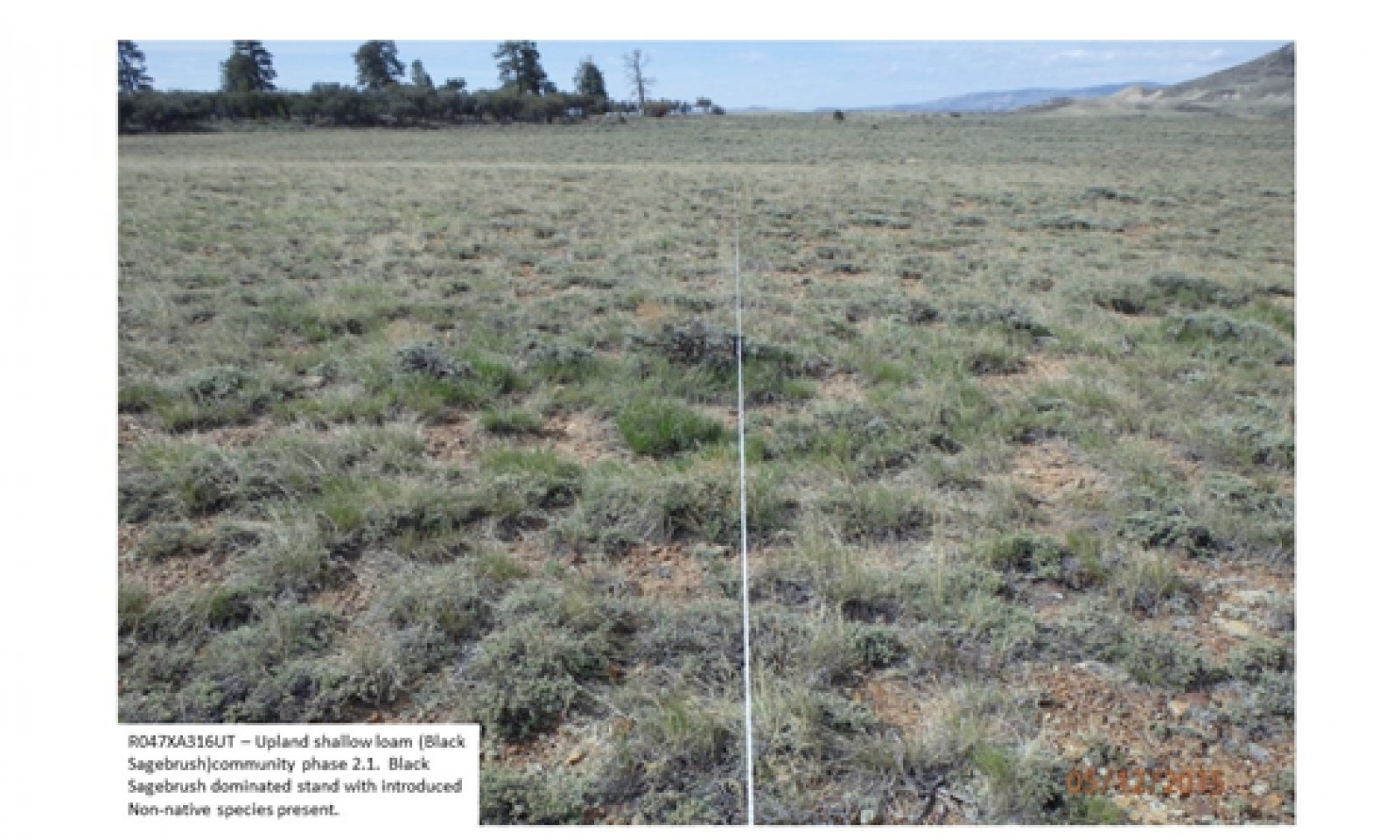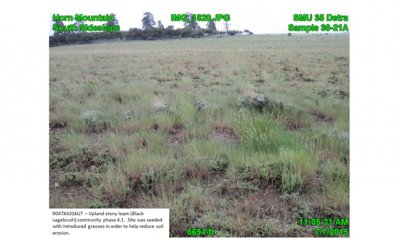
Upland Shallow Loam (black sagebrush)
Scenario model
Current ecosystem state
Select a state
Management practices/drivers
Select a transition or restoration pathway
- Transition T1a More details
- Transition T2a More details
- Transition T3A More details
-
No transition or restoration pathway between the selected states has been described
Target ecosystem state
Select a state
Description
The Reference State is a description of this ecological site just prior to Euro-American settlement but long after the arrival of Native Americans. The description of the Reference State was determined by NRCS Soil Survey Type Site Location information and familiarity with rangeland relict areas where they exist. The least modified plant community (1.1) within the Reference State would have been a sagebrush-dominated stand with black sagebrush (Artemisia nova), mountain big sagebrush (Artemisia tridentate spp. vaseyana), and low sagebrush (Artemisia arbuscular) and associated bunch grasses such as bluebunch wheatgrass (Pseudoroegeneria spicata), Nevada bluegrass (Poa secunda) and Indian ricegrass (Achnatherum hymenoides). Forbs such as Arrowleaf balsamroot (Balsamorhiza sagittata), phlox (Phlox spp.), and milkvetch (Astragalus spp.). The shallow and soils would have accentuated the effects of drought and reduced the chances of fire altering this state. The reference plant community (1.1) would have been relatively stable with occasional use by wildlife. However, heavy utilization by bison, elk, and Native American horses on these sites (1.1a) would have depleted the grasses creating a near monoculture of black sagebrush (1.2). Heavy browsing by deer during the dormant season of black sagebrush (1.1b) would have created an herbaceous variant (1.3). Occasional very wet years during El Nino-Southern Oscillation periods could have caused temporary soil anoxia (West 2000) (1.1c) killing the sagebrush and allowing the forbs and grasses to dominate for a short time (1.3). Infestation of some insects and pathogens on sagebrush (1.1c) could have led to a similar result where the herbaceous species become temporarily dominant (1.3). The interaction of an unusually dry period and heavy utilization by all grazers (e.g. deer, bison, elk, and horses used by native American) (1.1d) would have removed the palatable species from the plant community while allowing unpalatable, shorter-lived species such as yellow rabbitbrush (Chrysothamnus viscidiflorus ssp. viscidiflorus), locoweed, and phlox to predominate (1.4). The depauperate black sagebrush (Artemisia nova) community (1.2) could have also shifted to the unpalatable short-lived shrub community phase (1.4) in areas that have sustained heavy browsing by deer (1.2b). Relatively rocky sites such as these typically would not have declined in overall cover or productivity. However, the portion that is palatable may have changed appreciably. . Each of the phases within State 1 could have returned to Community Phase 1.1 if climate conditions were within the normal range of variability and there was a release from heavy grazing and/or browsing pressure (1.2a, 1.3a, 1.4a). A more complete list of species by lifeform for the Reference State is available in the accompanying tables in the “Plant Community Composition by Weight and Percentage” section of this document.
Submodel
Description
State 2 is identical to State 1 in form and function, with the exception of the presence of non-native plants and animals, possible extinctions of native species, and a different climate. State 2 is a description of the ecological site shortly following Euro-American settlement, which can be regarded as the current potential. The least modified plant community (2.1) within State 2 is a black sagebrush dominated stand with scattered mountain big sagebrush and low sagebrush and associated bunch grasses such as bluebunch wheatgrass Nevada bluegrass and Indian ricegrass Forbs such as Arrowleaf balsamroot phlox and milkvetch. A common non-native species in this state is cheatgrass. The generally shallow soils accentuate the effect of drought and reduce the chances of fires altering this state. This plant community is relatively stable under mixed use by wildlife and livestock. However, heavy utilization by bison, elk, horses, and domestic cattle on these sites during the growing season (2.1a) would deplete the grasses creating a near monoculture of black sagebrush (2.2). Heavy browsing by deer and sheep (2.1b) would create an herbaceous variant (2.3) because of year-round utilization of black sagebrush. Occasionally very wet years during El Nino-Southern Oscillation periods can cause temporary soil anoxia (West 2000) (2.1c) killing the sagebrush and allowing the forbs and grasses to dominate for a short time (2.3). Some insects and pathogens on sagebrush (2.1c) can lead to a similar result where the herbaceous species become temporarily dominant (2.3). The interaction of an unusually dry period and heavy utilization of grasses by bison, elk, horses, and domestic cattle (2.1d) would remove the palatable species from the plant community while allowing unpalatable, shorter-lived species such as yellow rabbitbrush, locoweed, and phlox to predominate. Species composition does not change, just their abundance (2.4). The depauperate black sagebrush community (2.2) may also shift to the unpalatable short-lived shrub community phase (2.4) with heavy utilization of browse by deer and sheep (2.2b). Relatively shallow sites such as these typically do not decline in overall cover or productivity, however, the portion that is palatable may change appreciably. Each of the phases within State 2 can return to Community Phase 2.1 when climate conditions are within the normal range of variability and grazing pressure is moderated (2.2a, 2.3a, 2.4a).
Submodel
Description
Invasive annuals and biennial forbs such as cheatgrass, Russian thistle, knapweeds, and horehound are favored by an increase in nutrient build-up in old, eutrophicated sheep bedgrounds. Where fire return intervals are frequent (3.2a) annuals such as cheatgrass and Russian thistle will predominate (3.1). Longer intervals between fire events (3.1a) will result in a plant community dominated by biennial forbs (3.2). The soil profiles of the plant communities within this state are mainly intact.
Submodel
Description
This State occurs where historic excessive livestock grazing reduced canopy cover, and in an attempt to prevent any additional excessive erosion it was intentionally seeded with species such as smooth brome and/or crested wheatgrass.
Submodel
Mechanism
The simultaneous introduction of exotic species, both plants and animals, and possible extinctions of native flora and fauna, along with climate change, will cause State 1 to transition to State 2. A return pathway back to State 1 would be impracticable because of these issues.
Mechanism
The Black Sagebrush/ Introduced Non-natives State will transition to the Introduced Annuals/Biennials State following a sustained period of excessive year-long livestock grazing, trampling and bedding, especially by large flocks of domestic sheep. Sheep bedding, salting, watering, and handling locations involve intensive trampling, urination and defecation. It is also common to see accelerated soil erosion in such locations.
Model keys
Briefcase
Add ecological sites and Major Land Resource Areas to your briefcase by clicking on the briefcase (![]() ) icon wherever it occurs. Drag and drop items to reorder. Cookies are used to store briefcase items between browsing sessions. Because of this, the number of items that can be added to your briefcase is limited, and briefcase items added on one device and browser cannot be accessed from another device or browser. Users who do not wish to place cookies on their devices should not use the briefcase tool. Briefcase cookies serve no other purpose than described here and are deleted whenever browsing history is cleared.
) icon wherever it occurs. Drag and drop items to reorder. Cookies are used to store briefcase items between browsing sessions. Because of this, the number of items that can be added to your briefcase is limited, and briefcase items added on one device and browser cannot be accessed from another device or browser. Users who do not wish to place cookies on their devices should not use the briefcase tool. Briefcase cookies serve no other purpose than described here and are deleted whenever browsing history is cleared.
Ecological sites
Major Land Resource Areas
The Ecosystem Dynamics Interpretive Tool is an information system framework developed by the USDA-ARS Jornada Experimental Range, USDA Natural Resources Conservation Service, and New Mexico State University.




